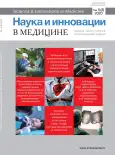Изучение использования электронных устройств студентами-медиками в транспорте и оценка риска их использования
- Авторы: Скоблина Н.А.1, Маркелова С.В.1, Козырева Ф.У.1, Булацева М.Б.1, Гончарова Г.А.2, Дроздовская В.В.1, Кондрашкина А.С.1
-
Учреждения:
- ФГАОУ ВО РНИМУ им. Н.И. Пирогова Минздрава России
- ФГАУ «НМИЦ Здоровья детей» Минздрава России
- Выпуск: Том 5, № 3 (2020)
- Страницы: 159-163
- Раздел: Гигиена
- URL: https://bakhtiniada.ru/2500-1388/article/view/47370
- DOI: https://doi.org/10.35693/2500-1388-2020-5-3-159-163
- ID: 47370
Цитировать
Полный текст
Аннотация
Цель – изучение использования электронных устройств студентами-медиками в вагонах метрополитена и оценка ими риска такого использования с последующим изучением уровня искусственной освещенности в вагонах метрополитена.
Материал и методы исследования. Были использованы социологический, инструментальный, статистический методы. Проведено анкетирование 123 студентов «Медицинского колледжа №2», 272 студентов РНИМУ им. Н.И. Пирогова, 176 преподавателей вуза и колледжа. Проведены измерения уровня искусственной освещенности в вагонах метрополитена с помощью поверенного комбинированного прибора «ТКА-ПКМ (43)». Статистическая обработка проведена с использованием пакета программ Statistica 10.0.
Результаты. 79,7% студентов колледжа, 93,4% студентов вуза и 30,9% преподавателей ежедневно используют электронные устройства в общественном транспорте. Субъективно риск использования электронных устройств в транспорте недооценивают 21,9% студентов колледжа, 49,2% студентов вуза и 16,4% преподавателей. Установлено, что в зоне wi-fi вагонов пассажирских электропоездов московского метрополитена типа 81-714 и 81-714.5м уровни искусственной освещенности не обеспечивают оптимальных условий для зрительной работы. В проведении работы по гигиеническому воспитанию студентов-медиков большую роль должны играть преподаватели, обладающие профессиональными знаниями по вопросам ЗОЖ и способные использовать эти знания в профессиональной деятельности.
Выводы. Выявлен фактор риска, который может формировать отклонения со стороны органа зрения у студентов-медиков.
Выявленный фактор является управляемым и связан со сформированностью у студентов-медиков навыков ЗОЖ.
Ключевые слова
Полный текст
Открыть статью на сайте журналаОб авторах
Наталья Александровна Скоблина
ФГАОУ ВО РНИМУ им. Н.И. Пирогова Минздрава России
Автор, ответственный за переписку.
Email: skoblina_dom@mail.ru
ORCID iD: 0000-0001-7348-9984
д.м.н., профессор, профессор кафедры гигиены
Россия, МоскваС. В. Маркелова
ФГАОУ ВО РНИМУ им. Н.И. Пирогова Минздрава России
Email: skoblina_dom@mail.ru
ORCID iD: 0000-0003-0584-2322
к.м.н., доцент, доцент кафедры гигиены
Россия, МоскваФ. У. Козырева
ФГАОУ ВО РНИМУ им. Н.И. Пирогова Минздрава России
Email: skoblina_dom@mail.ru
ORCID iD: 0000-0002-4041-9549
д.м.н., доцент, профессор кафедры гигиены
Россия, МоскваМ. Б. Булацева
ФГАОУ ВО РНИМУ им. Н.И. Пирогова Минздрава России
Email: skoblina_dom@mail.ru
ORCID iD: 0000-0003-1277-4890
к.м.н., доцент, доцент кафедры гигиены
Россия, МоскваГ. А. Гончарова
ФГАУ «НМИЦ Здоровья детей» Минздрава России
Email: skoblina_dom@mail.ru
ORCID iD: 0000-0002-1410-5546
к.м.н., старший научный сотрудник
Россия, МоскваВ. В. Дроздовская
ФГАОУ ВО РНИМУ им. Н.И. Пирогова Минздрава России
Email: skoblina_dom@mail.ru
ORCID iD: 0000-0003-1809-1759
студентка 3 курса лечебного факультета
Россия, МоскваА. С. Кондрашкина
ФГАОУ ВО РНИМУ им. Н.И. Пирогова Минздрава России
Email: skoblina_dom@mail.ru
ORCID iD: 0000-0002-1991-4860
студентка 3 курса лечебного факультета
Россия, МоскваСписок литературы
- Ushakov IB, Melihova EP, Libina II, Gubina OI. Hygienic and psychophysiological features of the formation of the health of students of a medical university. Hygiene and sanitation. 2018;97(8):756–761. (In Russ.). [Ушаков И.Б., Мелихова Е.П., Либина И.И., Губина О.И. Гигиенические и психофизиологические особенности формирования здоровья студентов медицинского вуза. Гигиена и санитария. 2018;97 (8):756–761]. doi: 10.18821/0016-9900-2018-97-8-756-761
- Setko NP, Bulycheva EV, Beylina E.B. Hygienic assessment of functional reserves and adaptive capabilities of students. Hygiene and sanitation. 2017;96(2):166–170. (In Russ.). [Сетко Н.П., Булычева Е.В., Бейлина Е.Б. Гигиеническая оценка функциональных резервов и адаптационных возможностей студентов. Гигиена и санитария. 2017;96(2):166–170]. doi: 10.18821/0016-9900-2017-96-2-166-170
- Kuchma VR, Sukhareva LM, Rapoport IK, et al. Population health of the child population, health risks and sanitary-epidemiological well-being of students: problems, solutions, technology activities. Hygiene and sanitation. 2017;96(10):990–995. (In Russ.). [Кучма В.Р., Сухарева Л.М., Рапопорт И.К. и др. Популяционное здоровье детского населения, риски здоровью и санитарно-эпидемиологическое благополучие обучающихся: проблемы, пути решения, технологии деятельности. Гигиена и санитария. 2017;96(10):990–995]. doi: 10.18821/0016-9900-2017-96-10-990-995
- Hue JE, Rosenfield M, Saб G. Reading from electronic devices versus hardcopy text. Work. 2014;47(3):303–307. doi: 10.3233/WOR-131777
- Gowrisankaran S, Sheedy JE. Computer vision syndrome: A review. Work. 2015;52(2):303–314. doi: 10.3233/WOR-152162
- Jaiswal S, Asper L, Long J, et al. Ocular and visual discomfort associated with smartphones, tablets and computers: what we do and do not know. Clin Exp Optom. 2019;102(5):463–77. doi: 10.1111/cxo.12851
- Skoblina NA, Shpakov AI, Markelova SV, et al. Students' subjective assessment of the impact of risk factors on vision when using electronic devices. Public health and habitat. 2020;4(325):48–51. (In Russ.). [Скоблина Н.А., Шпаков А.И., Маркелова С.В. и др. Субъективная оценка студентами влияния факторов риска на зрение при использовании электронных устройств. Здоровье населения и среда обитания. 2020;4(325):48–51]. doi: 10.35627/2219-5238/2020-325-4-48-52
- Matyukhin VV, Shardakova EF, Yampolskaya EG, Elizarova VV. Substantiation of physiological and ergonomic measures to reduce the development of fatigue when working with video display terminals. Health Risk Analysis. 2017;3:66–75. (In Russ.). [Матюхин В.В., Шардакова Э.Ф., Ямпольская Е.Г., Елизарова В.В. Обоснование физиолого-эргономических мероприятий по снижению развития утомления при работе с видеодисплейными терминалами. Анализ риска здоровью. 2017; 3: 66–75. doi: 10.21668/health.risk/2017.3.08
Дополнительные файлы






